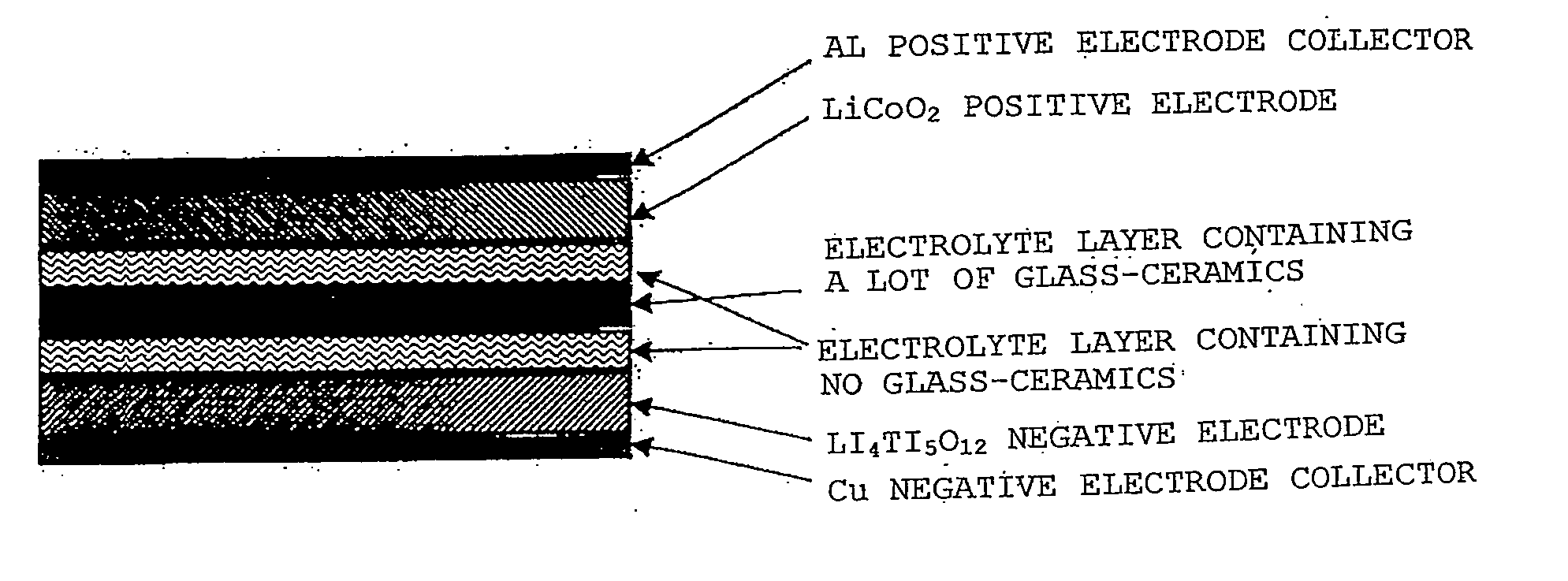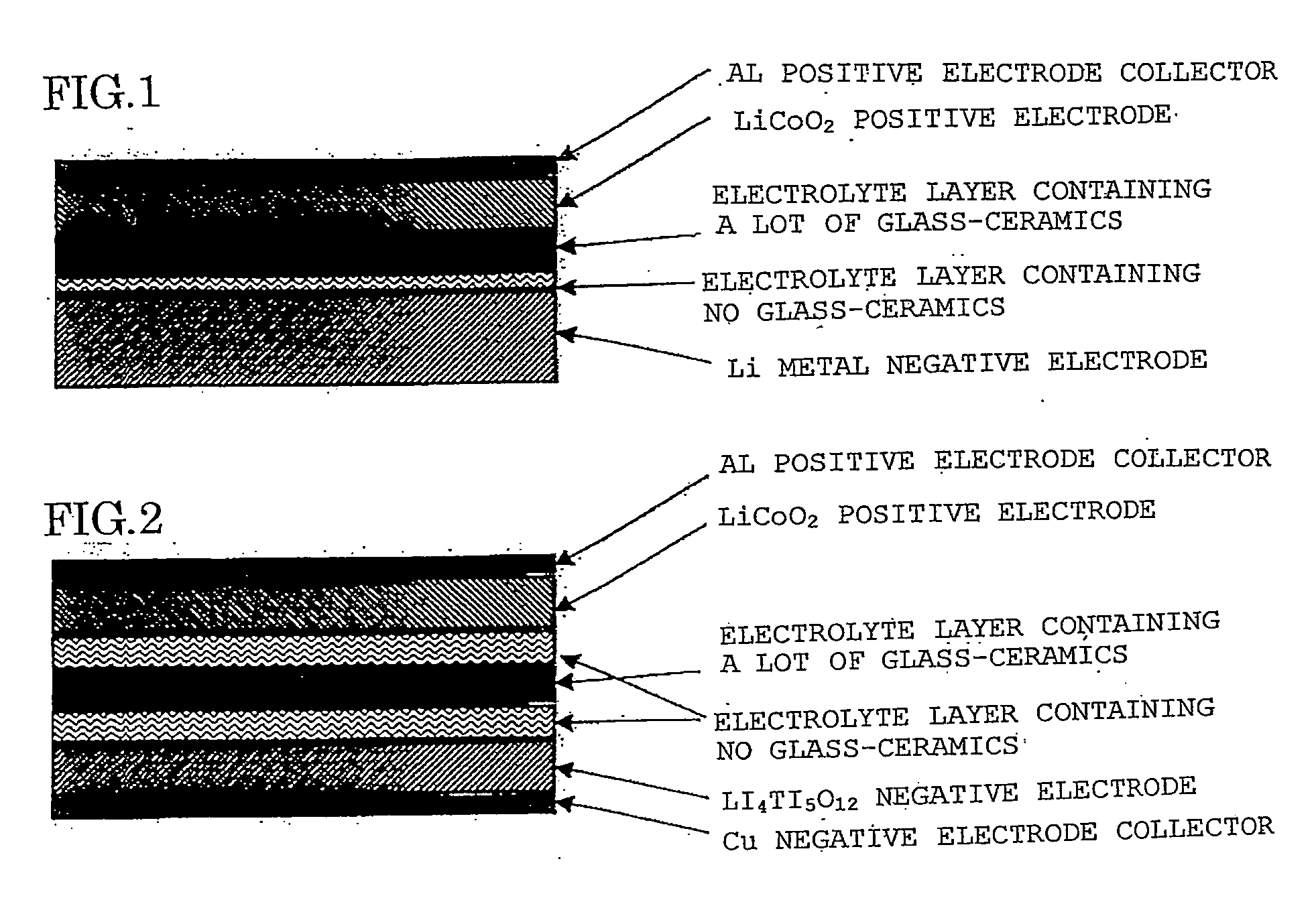Lithium ion secondary battery and solid electrolyte therefor
a solid electrolyte technology, applied in the direction of non-aqueous electrolyte cells, sustainable manufacturing/processing, non-metal conductors, etc., can solve the problems of short circuit between the positive electrode and the negative electrode, deterioration of the charge-discharge cycle characteristic of the lithium ion secondary battery, and significant reduction of lithium ion conductivity in the electrolyte. , to achieve the effect of high lithium
- Summary
- Abstract
- Description
- Claims
- Application Information
AI Technical Summary
Benefits of technology
Problems solved by technology
Method used
Image
Examples
example 1
Preparation of Lithium Ion Conductive Glass-Ceramics
[0082] Raw materials of H3PO4, Al(PO3)3, Li2CO3, SiO2 and TiO2 were weighed and mixed uniformly to make a composition of 35.0% P2O5, 7.5% Al2O3, 15.0% Li2O, 38.0% TiO2 and 4.5% SiO2 expressed in mol % on oxide basis. The mixture was put in a platinum pot and was heated and melted in an electric furnace at 1500° C. for three hours while the molten glass was stirred. Then, the molten glass was dropped into flowing water to produce flakes of glass. The glass was heated at 950° C. for twelve hours for crystallization and the target glass-ceramics was thereby obtained. By powder X-ray diffraction, it was confirmed that the main crystalline phase was Li1+x+y(Al, Ga)x(Ti, Ge)2−xSiyP3−yO12 (0≦x≦0.4, 0<y≦0.6). Flakes of the glass-ceramics produced were milled by a jet mill and a powder of the glass-ceramics having an average particle diameter of 5 μm and maximum particle diameter of 20 μm were obtained.
Preparation of Solid Electrolyte Con...
example 2
Preparation of Solid Electrolyte Containing a Lot of Glass-Ceramics
[0091] The glass-ceramics powder obtained in Example 1 and a copolymer of polyethylene oxide and polypropylene oxide loaded with LiBF4 as a lithium salt were mixed uniformly at a ratio of 80:20 in use of solvent in mixture of NMP (N-methyl 2 pyrolidone) and THF (tetrahydrofuran) and the mixture was coated by a roll coater on a PET film which had been subjected to releasing treatment and dried and then further dried under reduced pressure at 120° C. for removing the solvent by evaporation to derive a solid electrolyte sheet with thickness of 30 μm. Another PET film which had been subjected to releasing treatment was adhered to the solid electrolyte thus obtained. The composite electrolyte was then heated at 150° C. and was pressed by a roll press to remove bubbles remaining in the solid electrolyte. Then, the PET films on both sides of the solid electrolyte were stripped off. The solid electrolyte sheet obtained had ...
example 3
Preparation of Solid Electrolyte
[0103] Raw materials of H3PO4, Al(PO3)3, Li2CO3, SiO2, TiO2 and GeO2 were weighed and mixed uniformly to make a composition of 37.0% P2O5, 8% Al2O3, 15.0% Li2O, 20.0% TiO2, 4% SiO2 and 16% GeO2 expressed in mol % on oxide basis. The mixture was put in a platinum pot and was heated and melted in an electric furnace at 1400° C. for three hours while the molten glass was stirred. The molten glass was cast into a stainless mold to prepare a glass plate. This glass was heated in an electric furnace at 900° C. and the target glass-ceramics plate was thereby obtained. By powder X-ray diffraction, it was confirmed that the main crystalline phase was Li1+x+y(Al, Ga)x(Ti, Ge)2−xSiyP3−yO12 (0≦x≦0.4, 0<y≦0.6) in which a part of Ti was replaced with Ge.
[0104] This glass-ceramics was cut out into Φ20 mm and the both surfaces thereof were polished to derive disk type glass-ceramics (solid electrolyte) with thickness of 120 μm.
Preparation of a Positive Electrode a...
PUM
| Property | Measurement | Unit |
|---|---|---|
| Percent by mass | aaaaa | aaaaa |
| Percent by mass | aaaaa | aaaaa |
| Thickness | aaaaa | aaaaa |
Abstract
Description
Claims
Application Information
 Login to View More
Login to View More - R&D
- Intellectual Property
- Life Sciences
- Materials
- Tech Scout
- Unparalleled Data Quality
- Higher Quality Content
- 60% Fewer Hallucinations
Browse by: Latest US Patents, China's latest patents, Technical Efficacy Thesaurus, Application Domain, Technology Topic, Popular Technical Reports.
© 2025 PatSnap. All rights reserved.Legal|Privacy policy|Modern Slavery Act Transparency Statement|Sitemap|About US| Contact US: help@patsnap.com


